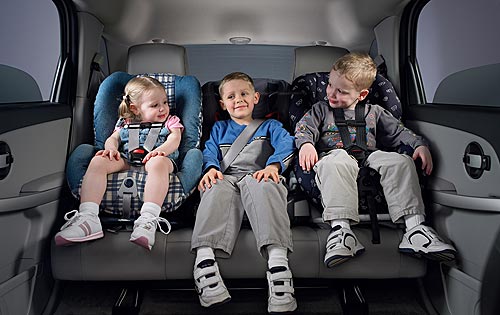
Keeping kids safe in the car is a concern for every parent. (image by babble.com)
If someone asked us when parents should consider and begin to practice child safety as it relates to cars, we’d answer that these things should start before their child is even born.
This may sound strange, but as any mother will tell you, the impact from a child begins months before birth. Thus, our answer to the previous question. Since mothers are carrying unborn children for the gestation period, child safety is impacted by the mother’s safety.
While expectant mothers are undergoing physical changes to their bodies, such as the expansion in their abdomens and widening of their hips in the first trimester — changes that continue for all 40 weeks they’ll carry their child — we suggest the same for them as we would any other driver. Wearing their seat belts.
We’ve heard the myth that seat belts endanger the lives of the unborn, but it’s just that — a myth, as long as seat belts are worn properly. That means expectant mothers should wear their seat belts, with the lap belt should be across her hips and below her belly, and the shoulder belt should be across her chest, between the breasts.
Car Seat Installation
With the new arrival of a bundle of joy, we shift from the safety of the mother to the child itself. It may be easy to think that installing a car seat is a simple matter. Put the child seat in the car, insert child, and we’re done, right?
Not so fast. The National Highway Transportation Safety Administration (NHTSA) says 75% of car seats are installed and/or used incorrectly. Fortunately, many hospitals have Child Passenger Safety (SPC) Technicians who can help parents of newborns properly install and secure their car seats.
But what do you do if you’re on your own? While the documentation and instructions included with the child seat is a good start, we think the NHTSA’s free child safety seatinspection centersare also worth the few minutes of time they’ll take to visit. These government-funded centers are based throughout the nation, and they’ll help to ensure a child seat is installed correctly,preferably using the LATCH system. LATCH, or the Lower Anchors and Tethers for Children system, has been standard equipment on every car sold in the United States since 2002. All child seats produced since that time are also LATCH compliant. The system employs different sets ofÿanchors to be used with child restraints.
However, if you don’t have access to these resources then you’re left to install it yourself. With all the latches and straps installation may seem complicated. But don’t worry; we’ve got you covered below.
Installation for Infants
The primary role of a car seat for infants is to protect the head and neck, which are the most vulnerable to long-term complications in the event of a collision. There are two types of car seats for infants: rear-facing, infant-only; and convertible seats. Rear-facing, infant-only care seats are ideal for newborns but they become obsolete once the child grows to more than 20 pounds. When you’re installing your little one’s car seat we suggest you follow the steps outlined in the manufacturer’s instruction manual. However, here are some general tips that will help you properly secure your newborn. If you’re more of a visual learner you can watchinstallation videos provided by the NHTSA. - If you can move the car seat more than an inch then the straps aren’t tight enough. To get them tight enough we suggest you find a way to put your weight into the car seat and then pull the straps as hard as you can. It’s important that the seat moves as little as possible while you’re in transit.
- Ensure the carrier straps are tight and the harness clip is even with your baby’s shoulders or armpits and the straps are in the slot that lines up close to the infant’s shoulders.
- If your baby has some extra space in the seat you can place rolled receiving blankets or towels on each side to keep him or her from wobbling. Avoid placing anything under the harness straps.
- Locking clips are necessary for some vehicles made before 1997. This is necessary because these vehicles don’t have seat belts that lock when the brakes are slammed, so the clip keeps belt from slipping if an accident occurs.
- Your baby’s head should be at least two inches below the top of the safety seat and make sure the seat is set at a 30 to 45-degree angle.
- You can see more tips at DMV.org or Kids Health.
Convertible seats, the alternative to rear-facing, infant-only seats, are designed so that they can be used by infants after they’re heavier than 20 pounds. When the baby reaches that weight the seat can be turned to face forward and it’s secured with three types of harnesses: T-shield, tray shield, and five-point. All of these types meet required safety standards, but the five-point harness is regarded as the best option since it can be tightened to fit snugly and it doesn’t get in the way of the baby’s head. When installing a convertible seat you should make sure all straps are as tight as possible to prevent it from wobbling.
Ages One to Three
While infants should always be placed in rear-facing car seats, once a child has reached at least one year of age and weighs at least 20 pounds they can utilize forward-facing child safety seats installed in the rear of the car. That being said, they’re safer in a rear-facing seat, so keep them in one for as long as possible.Forward-facing seats, like the ones that come before, should be installed using LATCH rather than seat belts, if possible. Here are some other tips:
- If you’re installing a forward-facing seat make sure it’s set directly against the back and bottom of the car seat. When you’re installing the seat make sure to put weight on the seat to push it back as far as possible so the straps will be as tight as they can be.
- Make sure the seat can’t move side to side or tip forward more than an inch. If it does then unbuckle it and try again.
- If your car was made before 1996 then you’ll probably need to buy a locking clip to prevent the lap and shoulder seat belts from slipping.
- Make sure the straps lie flat and tug on them to make sure they’re secure once your baby is fastened into the seat.
- If you can pinch any of the harness material between your fingers then it’s too loose and needs to be adjusted.
Ages Four to Seven
There are no rear-facing car seats available for this age group, and we don’t know of any children of this age group that would be content to sit facing the rear of the car. So, once a child reaches age four, you’ll have no choice but to move to a forward-facing seat.
Keep a child in this age range in their child seat until they outgrow either the height or weight limits specified by the seat manufacturer. Once this happens, it’s time to switch to a booster seat.
Ages Eight to Twelve
Once a child reaches eight years of age or is at least 4’9” tall, they should be placed in booster seats. Most booster seats simply elevate the child’s seating position and enable them to use the standard seat belts on a car. LATCH is not required nor should it be used with booster seats.
At some point during this period, you’ll likely transition the child from booster seat to just using the standard seat belt of the automobile with no otherÿencumbrances. Make sure they’re wearing the belt properly, with the lap portionÿacross their upper thighs and the shoulder portion across their chest.
Other Considerations
We’ve heard lots of chatter regarding the so-called “combination seats.” These seats are marketed as being able to go from a rear facing infant seat to a forward facing toddler seat and then finally to a booster seat for older children. A testing study performed by the Insurance Institute for Highway Safety (IIHS) found significant problemswith these combination seats. Children should always ride in the back seat of a car, if possible, no matter if they’re in a car seat, a booster seat, or if they’re old enough to wear seat belts.ÿAll modern cars now have both driver side and passenger side front airbags, which are designed for full-sized adults. Airbags can injure or kill a child, and the back seat is simply the safest place in the car.
Finally, don’t assume that just because your child isn’t in a car that all auto-related dangers areÿabated. Child pedestrians are killed at a greater rate than any other age group. In fact,male children, aged 5 to 9 years old, are the largest group of pedestrians killed every year. Children can still fall victim to an automobile by darting into a road without looking or by playing on a street. 






